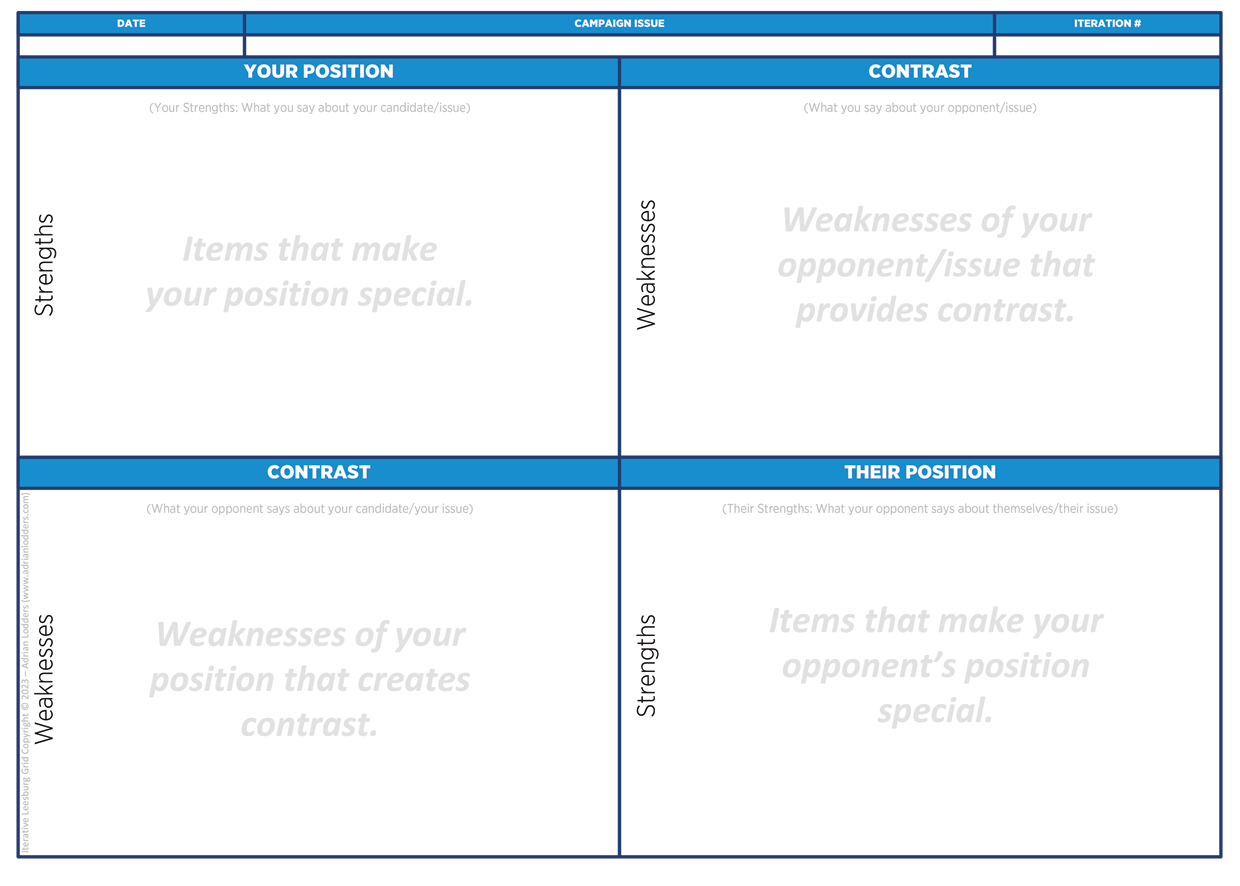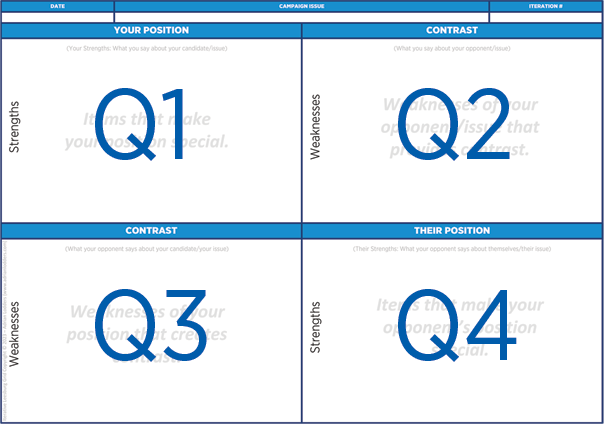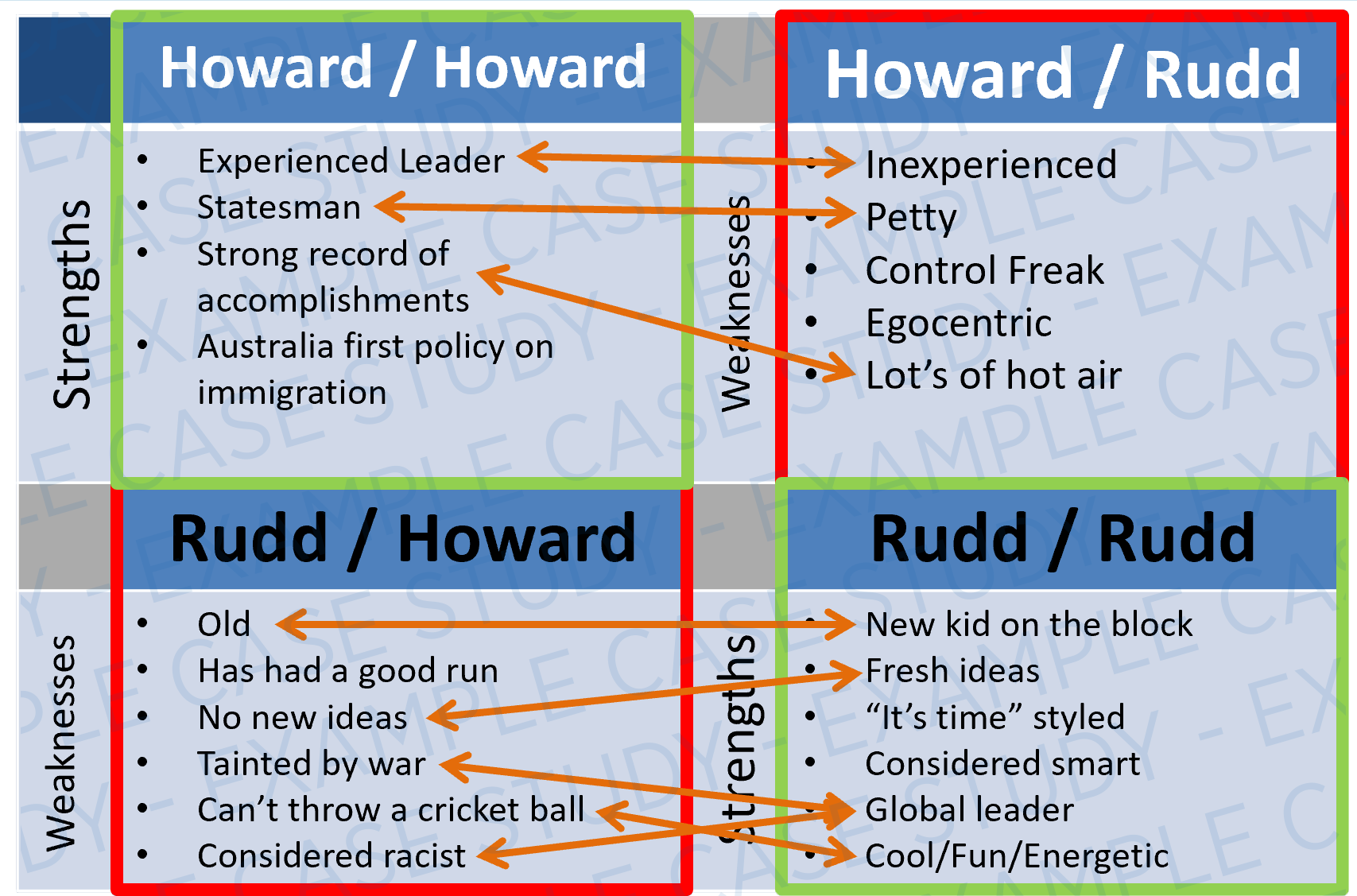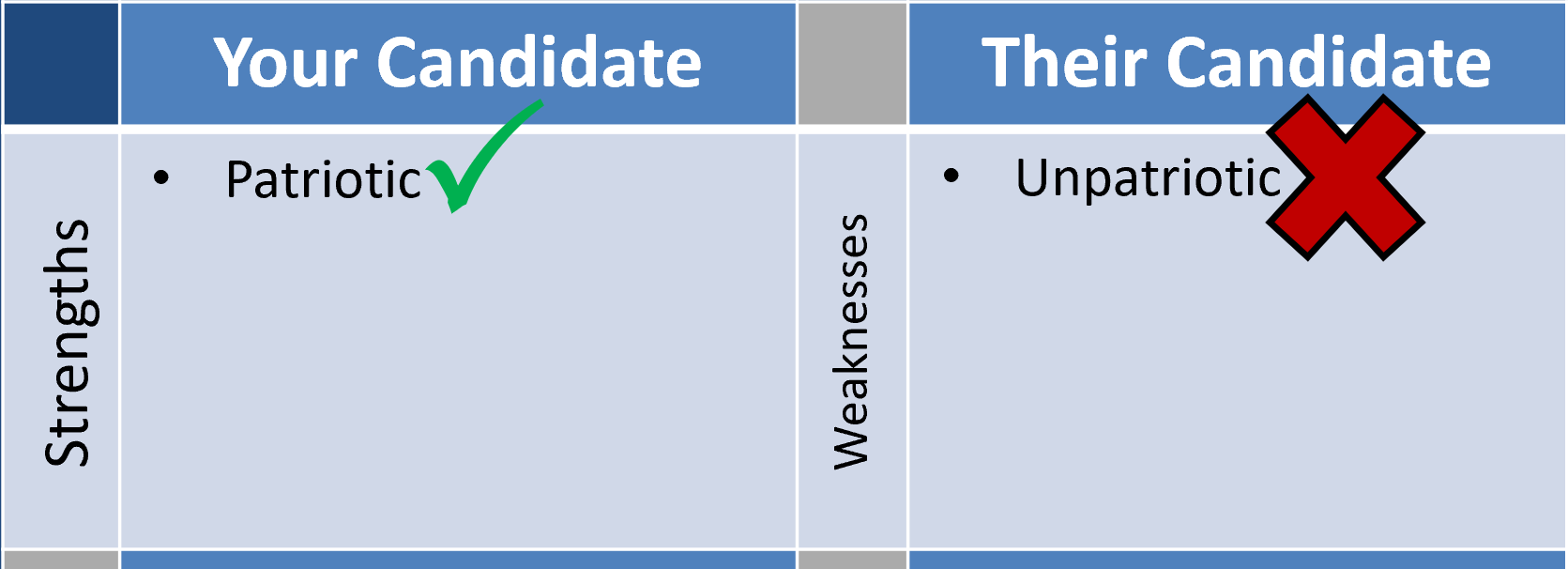Message Strategy: Contrast and Framing
Wednesday, July 26th 2023 — Issue Framing, Leesburg Grid, Message Strategy, Strategic Communications
Introduction
Crafting a narrative that highlights the strengths of your position while contrasting it against your opponent's weaknesses is a considerable challenge for any political or strategic communications professional.
This challenge extends to both candidates and individual issues, which can shift dramatically based on your target audience and their motivations.
Given these complexities, it's crucial to understand that you may need to tailor different messages for each candidate and each issue, depending on the audience segment (or 'target universes') you're trying to engage.
What's required is akin to a SWOT analysis, but specifically for messaging. Fortunately, a tool exists for this very purpose: the Leesburg Grid. Simple in design, the Leesburg Grid can be quickly put together on a whiteboard or a piece of paper with minimal preparation, serving as a powerful aid in your communications strategy.
With the Leesburg Grid, the task of identifying and contrasting narratives becomes significantly more manageable, making it an invaluable tool for communications and political professionals.
What does the Leesburg Grid do?
The Leesburg Grid is a strategic tool used for conducting a contrast analysis between your candidate or position and that of your opponent or an opposing stance in regards to a public policy issue, it is the first step in framing a message.
It comprises four quadrants. By systematically filling in these quadrants, you can create a clear contrast between your candidate or position and that of your opponent, thereby helping to shape effective messaging and strategies.
History
The Leesburg Grid was reportedly crafted over a single weekend in the early '90s by a group of senior Republican strategists in Leesburg, Virginia. This intriguing piece of political history was introduced to the author in 2015, during a public policy course near Washington D.C. Professor Emeritus F. Christopher Arterton, Founding Dean of the Graduate School of Political Management at George Washington University, verifies this account in his book, Strategy in Politics: Plotting Victory in a Democracy.
Is it used in Australia?
The Leesburg Grid is utilised by various activist groups, independent candidates, and some minor parties in Australia. Its relevance was spotlighted at the inaugural Australian CPAC event in 2019. It became evident that most attendees were unfamiliar with the Leesburg Grid, thus highlighting the necessity for enhanced training and professional development amongst Australia's centre-right political staff.
How to use the Leesburg Grid

There are four quadrants you need to complete:
Quadrant 1:
What will we say about your candidate/position?
Quadrant 2:
What will we say about the opponent/their position?
Quadrant 3:
What will the opponent likely say about your candidate/your position?
Quadrant 4:
What will the opponent say about themselves/their position?

Each of these need to be viewed from the lens of the constituents you intend to engage with.
What are we looking for?
Start by forming a clear, basic message, while also anticipating what your opponent's message might be. The key here is to identify the differences, which will act as points of contrast. These contrasting points can help you shape the perception of your candidate or policy issue, ideally before your opponent gets a chance to do so.
The Leesburg Grid is an effective tool in this process. By identifying and delivering a well-crafted message to your target audience, your candidate or policy stance can gain a first-mover advantage.
In certain scenarios, your candidate or position may be a reaction to a candidate or position that you and your coalition of supporters disagree with. In this case, you'll need to carefully delineate your opponent's character in Quadrant 2 of the Leesburg Grid, while highlighting your own contrasting attributes in Quadrant 1.
It's important to remember that contrast alone isn't sufficient. You should also be able to present your candidate or position as a credible alternative to your opponent. As Saul Alinsky stated in his 12
The price of a successful attack is a constructive alternative.
So, when defining your opponent or their position, you should always be paired with your own contrasting position from Quadrant 1.
Example
As we develop a Leesburg Grid, we need to bear in mind three important points:
- Facts matter, but perception does too.
- The facts we use must be true.
- We must play the Devil's Advocate to fully understand the situation.
This means personal biases need to be set aside, particularly when considering Quadrants 3 and 4.
Let's dive into a real-world hypothetical example: the 2007 election scenario between Australia's incumbent Prime Minister, John Howard, and Opposition Leader, Kevin Rudd. Since neither is currently active in Australian politics, their case provides a useful study.
During this period, activist organisations like GetUp and figures like Mr. Rudd were receiving significant media attention. Teenagers who had witnessed the September 11 attacks and the Global War on Terrorism were coming of voting age. Many felt weary due to the incumbent government's activities.
Contextually, we also consider the cricket ball incident of 2004. Fifteen years later, the media was still referencing that event, demonstrating its influence on the body politic. During the 2007 election, many progressive activist groups labelled Mr. Howard as racist due to his strong borders stance for Australia. Part of this also hinged on a speech where Mr. Howard stated, "...we will decide who comes to this country and the circumstances in which they come."
Here, we've workshopped a grid intended to support Mr. Howard as our candidate. Note that Quadrants 2 and 3 include perceptions. In politics, for many, perception is reality, shaped by various influences including media, family, school, and peers.

In the below grid, the green boxes (Quadrant 1 and 4) help identify positive traits for both candidates, while the red boxes (Quadrant 2 and 3) help highlight negative traits. The orange lines indicate areas of contrast.

From this data, you will enter the next phase of your message strategy plan. For example you can develop message strategies for the following:
- A message that contrasts your opponent.
- An offensive strategy.
- A defensive strategy.
By using the Leesburg Grid, you reduce the possibility of crafting messages and narratives that are on based assumptions, or develop message strategies that fail to provide clear contrast between your candidate or position and that of your opponent.
Case Study Disclaimer
Ethical Considerations
When utilising Quadrants 1 and 2 of the Leesburg Grid, you might spot certain characteristics of your candidate or position that stand out against those of your opponent.
Consider, for instance, a scenario where two candidates are vying for the position of prime minister. If in Quadrant 1 you emphasise your candidate's patriotism - a trait not overtly demonstrated by your opponent - a question arises: does this make your opponent unpatriotic?
Most likely, the answer is no.
Unless there is concrete evidence such as public disparagement of the country or other signs of disloyalty, labelling your opponent as unpatriotic should be strictly avoided.

Remember, while it would be perfectly acceptable to highlight your candidate's patriotism, it is also important not to falsely define your opponent as unpatriotic. The Leesburg Grid is a tool for contrast and message framing, it is not for misrepresentation. Careful, ethical considerations are vital when framing messages and creating contrasts in political or policy communication.
Misrepresentation can backfire, damaging credibility and the integrity of the political discourse. Political professionals have a responsibility to maintain this integrity while working towards their clients goals. Members of the American Association of Political Consultants (AAPC) are also subject to the Code of Professional Ethics, which outlines such expectations.
Downloads
To aid in crafting your own messages, I've provided editable PDF versions of the Leesburg Grid. These can be extremely useful in workshopping and analysing your candidates or issues.
Remember, the process of creating effective messaging is iterative. Don't be discouraged if your first few attempts don't yield clear, contrasting narratives. Keep refining your work using these grids, and you'll soon see progress.
Available Downloads:
Additional notes
It's important to remember that a single issue may affect segments of the population differently. Therefore, consider creating multiple Leesburg Grids or message strategies that reflect the specific values and language of each target group. This may involve A/B split testing and several iterations until you achieve the desired outcome.
Take the example of discussing superannuation with different age groups. The language and approach you'd use to communicate with 25 to 35-year-olds will differ significantly from how you'd converse with individuals who are retired or nearing retirement.
Neglecting to tailor your messaging to the appropriate audience can have disastrous consequences, particularly in large-scale campaigns. For local campaigns or issues, such as saving a local creek or preserving a historical building, the requirement for such a nuanced approach may not be as critical. Nonetheless, knowing your audience and adjusting your messaging accordingly is always good practice.
Also, remember that public sentiment can change, and new information can come to light. Therefore, you should regularly review and update your Leesburg Grid and recraft your message strategies as necessary.
Strategic Communications Services
As a seasoned professional, Adrian understands the complexities and nuances of strategic messaging and the unique challenges it presents. As someone who has witnessed first-hand the power of the Leesburg Grid in successfully framing message strategies, Adrian can guide you through this process, ensuring it's tailored to your specific needs.
If you're interested in harnessing the potential of the Leesburg Grid, assistance with strategic communication and crafting your message, or you require training for your team, Adrian may be available to assist. He can act as a facilitator, trainer, or consultant, empowering you to navigate the dynamic landscape of political and corporate communication with confidence.
To contact Adrian, click here.